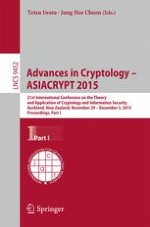The two-volume set LNCS 9452 and 9453 constitutes the refereed proceedings of the 21st International Conference on the Theory and Applications of Cryptology and Information Security, ASIACRYPT 2015, held in Auckland, New Zealand, in November/December 2015.
The 64 revised full papers and 3 invited talks presented were carefully selected from 251 submissions. They are organized in topical sections on indistinguishability obfuscation; PRFs and hashes; discrete logarithms and number theory; signatures; multiparty computation; public key encryption; ABE and IBE; zero-knowledge; attacks on ASASA; number field sieve; hashes and MACs; symmetric encryption; foundations; side-channel attacks; design of block ciphers; authenticated encryption; symmetric analysis; cryptanalysis; privacy and lattices.
